Digital nomad report from Indochina
preamble
From October to December 2022, Pirate Radio set off from Hong Kong and spent nearly two months visiting Bangkok, Chiang Mai, Phuket in Thailand, and Penang in Malaysia in the form of digital nomads. We are trying to explore the possibility of establishing digital nomad community nodes and networks between the four cities on the line from the Indochina Peninsula to the Andaman Sea, and establishing the "Great Waterway" of Web3.
In the past few weeks, our itinerary and plan have gradually attracted the attention of many friends on social media. The series of exchanges, experiences along the way, and especially the interaction with various communities have not only allowed us to meet many colleagues. People in "DAO" also made us think it necessary to publish a pragmatic and detailed report to provide some references for all digital nomads who are willing to join us in putting the community's wishes into practice. Subscribe to Pirate Radio to follow everything we've been through and the latest developments in the digital nomad community -
Part 2: The Geography of Digital Nomads—Where Are We Going?
“There are people who guard their identity with cryptocurrency and with themselves, and these people are often digital nomads, and to them, it doesn’t matter whether they’re watching the sunset in San Francisco or Singapore, or whether an exchange is up or down, it matters. What’s great is that every day they can connect with their community.”
- Balaji: Network Nation
1. Digital nomad-friendly countries from a global perspective
Although there are many tourist resorts to choose from around the world, for digital nomads, only places suitable for digital nomad life are suitable destinations. With dynamic factors such as seasons, climate, and visa policies of various countries, the first thing a digital nomad has to learn is to weigh all the information before making a judgment and decision.
Before embarking on a trip to a certain place, everyone who is determined to go on the road has different wishes and needs; there are also many news and statistical reports on the Internet, various lists such as "Top 20 favorite places for digital nomads" Single... These public information and personal needs are intertwined, like an information black hole, making it difficult to make a quick judgment.
Of course, digital nomads like good places with beautiful scenery and low prices, but if the local broadband Internet is not available, or the visa policy is too strict, this place will not be suitable for digital nomads.
There are some key factors that determine whether a place will be popular with digital nomads in a first-principles manner: price index, wireless network bandwidth, average temperature, security situation, etc. Taken together, these indicators determine whether a place, town or country is friendly enough for digital nomads.
We can use the method of enumerating parameters and weighting to score one by one, and observe how some of them win.
For example, the UK's ClubMed website uses this method to list the 15 best countries for digital nomads. The parameters referenced in this list include temperature, cost of living, internet speed and number of offline activities: https://www.clubmed.co.uk/l/blog/digital-nomad-index
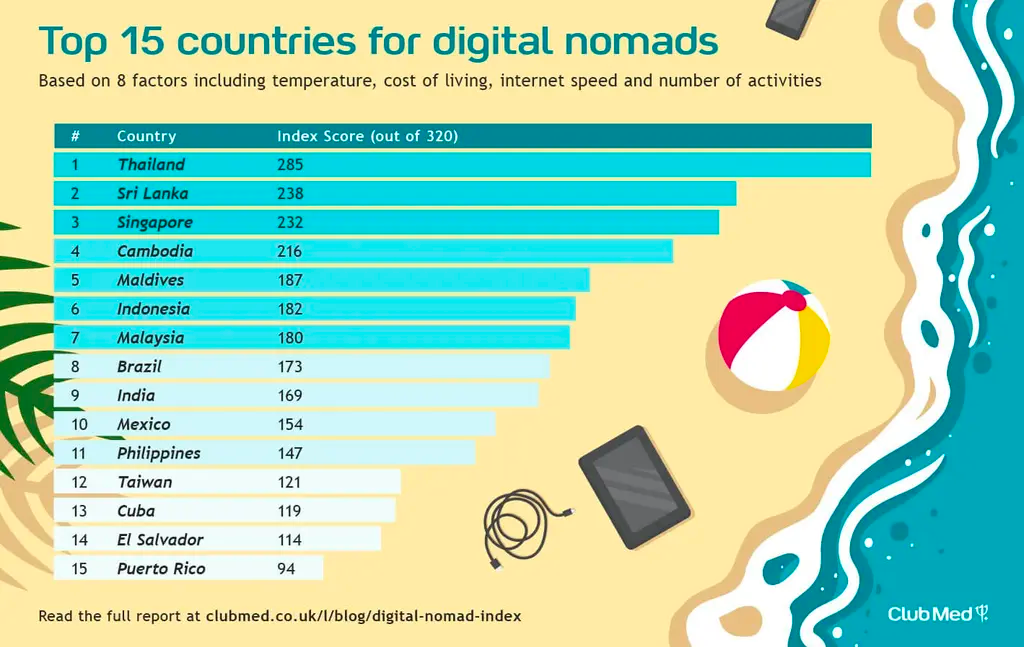
It can be seen that Thailand is at the top of the list, and many countries in Southeast Asia are also on the list, and they rank high.
We also consulted quite a few similar reports in recent years (eg https://abrotherabroad.com/digital-nomad-statistics/ ). We found that from the perspective of the English-speaking world, Thailand in Southeast Asia, Mexico in South America, and Portugal in Western Europe are all places favored by digital nomads; Southeast Asia was rated as the most popular region for digital nomads with 34% of the votes , followed by Central America received 16 percent of the vote and South America 13 percent.
There is also a future factor to consider. As COVID-19 gradually subsides and the world reopens, residents of many countries' major cities are beginning to consider starting work elsewhere. Some tourist attractions have also begun to focus on the digital nomad market to make up for the lack of tourists caused by the epidemic.
Many countries, including Bermuda, Antigua and Barbuda, Barbados, Estonia, Thailand, and Georgia , have adopted special visa programs to welcome high-income, high-quality digital nomads to live and live in their territories.
According to the latest statistics from Nomadgirl ( nomadgirl.co ), 49 countries have implemented digital nomad visas.
https://nomadgirl.co/countries-with-digital-nomad-visas/
The ever-growing list of digital nomad-friendly countries means that there may be new good news coming out at any time, and there will be more and more countries and regions for nomads to choose from.
2. The choice of Chinese digital nomads
Different people have different perspectives. Even if an indicator function about ideal destinations is constructed, the weights of various variables are different, which will make the conclusions of each report inconsistent.
For example, there are various lists of "digital nomad destinations" around the world. The first list comes from someone's blog ( https://www.websiteplanet.com/blog/best-locations-digital-nomad/ ): This is a cost list of various digital nomad locations, listing where The cost of living is relatively low.

The following "Digital Nomad City Ranking" comes from The Instant Group, a UK-based flexible working solutions provider:

The picture below is from ClubMed in the UK, which also lists the 20 best places for digital nomads. Compared with the above, there are almost no duplicates. This shows that everyone is in a state of disagreement about what is the best place for digital nomads.
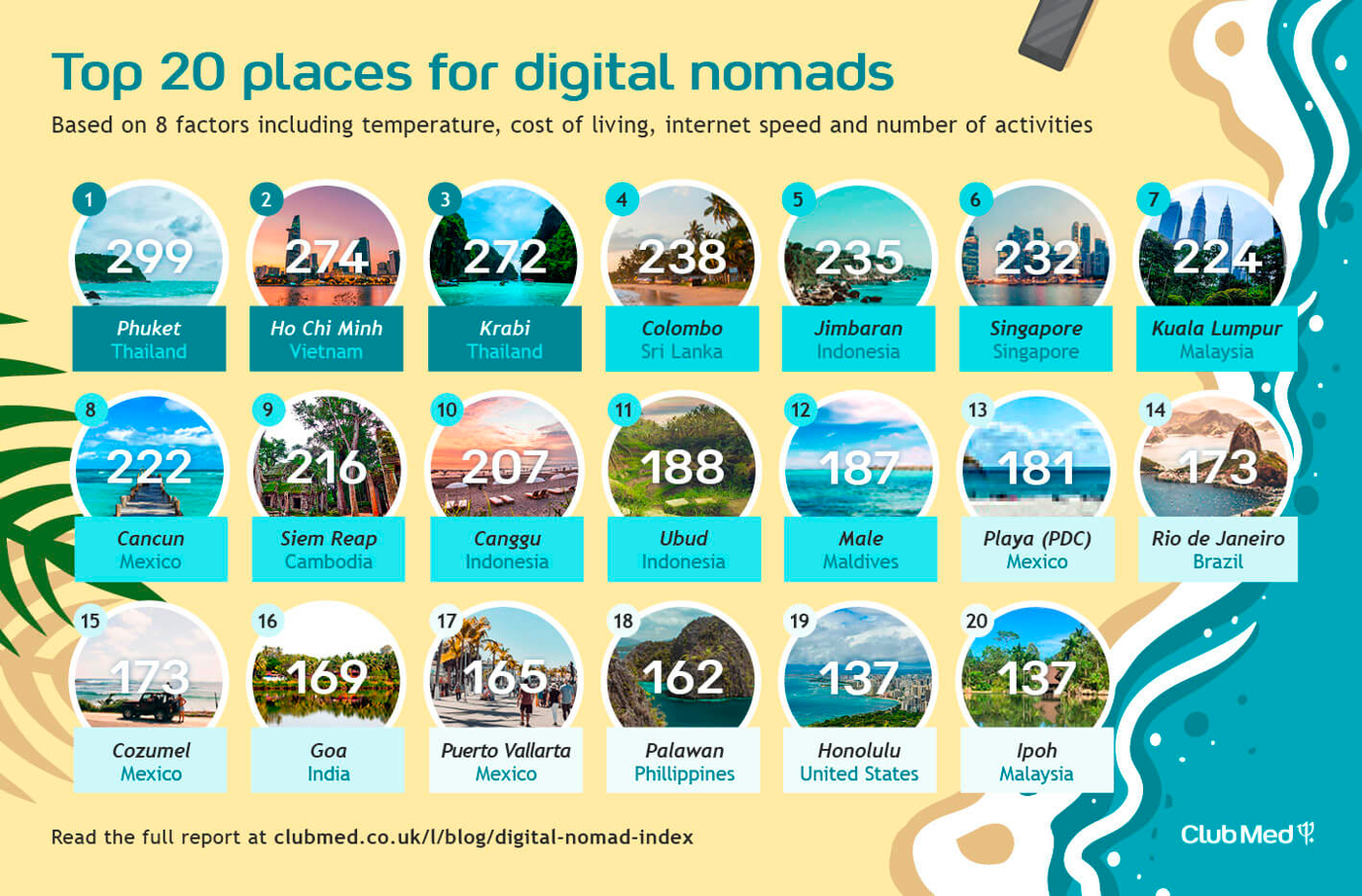
The three top cities include Tbilisi in Georgia , Koh Lanta in Thailand, Lisbon in Portugal, Bangkok in Thailand, Phuket in Thailand, and Ho Chi Minh in Vietnam. We have noticed that cities in Southeast Asia and Thailand account for a very high proportion.
Of course, this is the view of the English-speaking world. When we change our perspective to observe as a Chinese digital nomad, we will naturally come up with a list of destinations suitable for Chinese digital nomads.
Compared with people from other countries, the main difference between Chinese digital nomads lies in the scope of application of passports and visa policies of corresponding countries. Wikipedia uses the following picture to present very intuitively the countries that implement visa preferential policies for holders of ordinary passports of the People's Republic of China.

It can be seen that Chinese passports are easier to use when traveling to Central Asia, Eastern Europe, the Middle East, and East Africa. In Southeast Asia, the advantages of visa policies are also more obvious.
In addition, determined by geographical factors, the advantages of Southeast Asia include being closer to China and having similar culture, customs and eating habits. There are often many overseas Chinese communities with a long history here, and many students from the southern coastal areas can use their hometown dialect.
The following is a schematic diagram to illustrate the geographical location, distribution, and cultural and religious geographical structure of Southeast Asian countries.
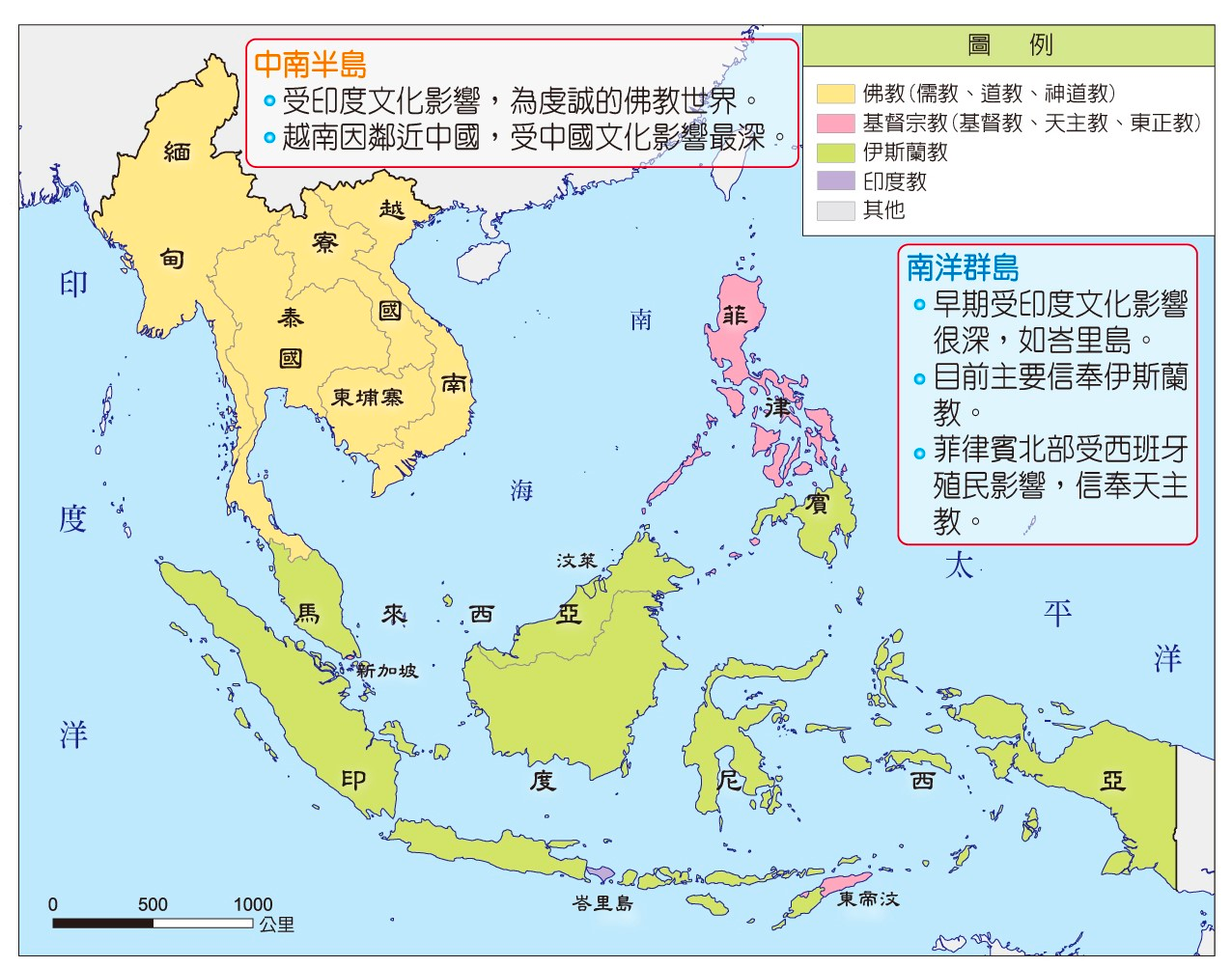
Southeast Asia is mainly composed of the Indochina Peninsula and the Nanyang Islands. There are 11 countries in total: Thailand, Malaysia, Indonesia, Vietnam, Myanmar, Laos, Brunei, Cambodia, Singapore, the Philippines, and Timor-Leste. The visa policies of Southeast Asian countries are not the same. For digital nomads holding Chinese passports, the current (i.e. winter 2022) visa policy is roughly as follows:
Thailand : You can apply for visa on arrival (30 days), tourist visa (2 months), and visas for work and business, but currently Chinese people are not allowed to apply and process before studying abroad. Long-term visas can be processed for elite visas, and the validity period ranges from 5 to 20 years. Thailand is trying to introduce a new digital nomad visa, but the issue has not yet been fully implemented.
Malaysia : These two types of visas are available: visa-free (eNTRI) and electronic visa (eVISA). They are all processed online, and you can choose one of the two types of visas.
Indonesia : Since June 10, 2015, Indonesia has implemented a visa-free policy for China. For entry offices that do not support the visa-free policy, visas on arrival can be applied for. Mainland Chinese residents can enter the country at the five international airports in Jakarta, Bali, Medan, Surabaya, and Batam, or at the four seaports of SRI BINTAN PURA, BATAM CENTER, SEKUPANG, and TANJUNG UBAN. The length of stay is 30 days, and the visa on arrival can be extended for another 30 days.
Vietnam : You can apply for these two types of visas: pre-departure application and visa-on-arrival. You can choose one of the two types of visas. At the same time, one-month, two-month single or multiple round-trip visas are provided. Duration of stay in Vietnam: 30 days for 1-month single or multiple visas; 90 days for 3-month single or multiple visas.
Myanmar : No visa on arrival. Electronic visa and tourist visa are valid for 90 days, and the allowed time to stay in Myanmar is 28 days.
Laos : visa on arrival (15 days), tourist visa (30 days).
Brunei : visa on arrival (14 days), tourist visa (14 days).
Cambodia : You can apply for these three types of visas - electronic visa (30 days), visa on arrival (30 days), embassy visa (30 days). You can choose one of the three types of visas. At the same time, one-year, two-year and three-year multiple-entry visas are provided.
Singapore : You can apply for a tourist visa. The validity period and number of entries are determined by the Singapore embassy.
Philippines : You can apply for a tourist visa (30 days).
3. A road sign for backpackers: Banana Pancake Road
The experience of digital nomads varies greatly from person to person, with some experienced and others just starting out. The inheritance and connection of experience is an important part of community culture. If one day, a digital nomad is no longer satisfied with Dali, Sanya, and Anji, which are mature domestic digital nomad permanent residences, and starts to look beyond the borders, a complete, friendly and loving foreign offline The community will play an incomparably huge role. It will embrace new arrivals like an overseas home port, establish a station for them to stay, stay, rest, and replenish, and provide cultural and life adaptation and buffering. At the same time, of course, it also needs to be able to accept the veterans of the digital nomads, and grow into a transit station in the dual sense of geography and information as soon as possible.
From the previous arguments, we can draw a preliminary conclusion: Southeast Asia is an ideal choice for Chinese digital nomads. So how to choose the first foothold? We need to further zoom in on the map to find the appropriate "novice village" and "starting station".
We can take cues from the backpacker's route.
Western backpackers are a mature cultural group, and almost all young people spend some time on the road to measure the world with their feet. Backpackers have made a lot of explorations. The popular travel guide "Lonely Planet" has been kept updated for many years, providing all the experiences backpackers need; youth hostels around the world constitute a cheap accommodation network, providing Stopped station.
In terms of the historical origins of backpackers and Hippies to Geek, we can also think that digital nomads are also a continuation of backpacker culture. The Banana Pancake Road - "Banana Pancake Trail" or "Banana Pancake Circuit" is the name of the route that backpackers explore and develop in Southeast Asia.
"The Banana Pancake Road" isn't clearly defined geographically. Some versions pass through Hong Kong, while others do not include Dali, Yunnan, nor pass through China. But everyone agrees that the "Banana Pancake Road" started on Khao San Road in Bangkok. It can be said that in the English context, it is almost a metaphor to refer to places in Southeast Asia and Western tourists like to go.

The reason why this banana pancake route is very worthy of reference for digital nomads is that the places it passes through have already had decades of perfect infrastructure for receiving tourists. Hotels, B&Bs and resorts are dotted all over, and often have beautiful scenery and cultural history. There are many resorts among them.
Here are a few different versions of "The Road to Banana Pancakes."
The first is a relatively large and comprehensive version that extends from the Himalayas in the north to the Hengduan Mountains in the southwest - Dali and Tiger Leaping Gorge in China, Bali in the south, the Philippines in the east, and Goa in India in the west:
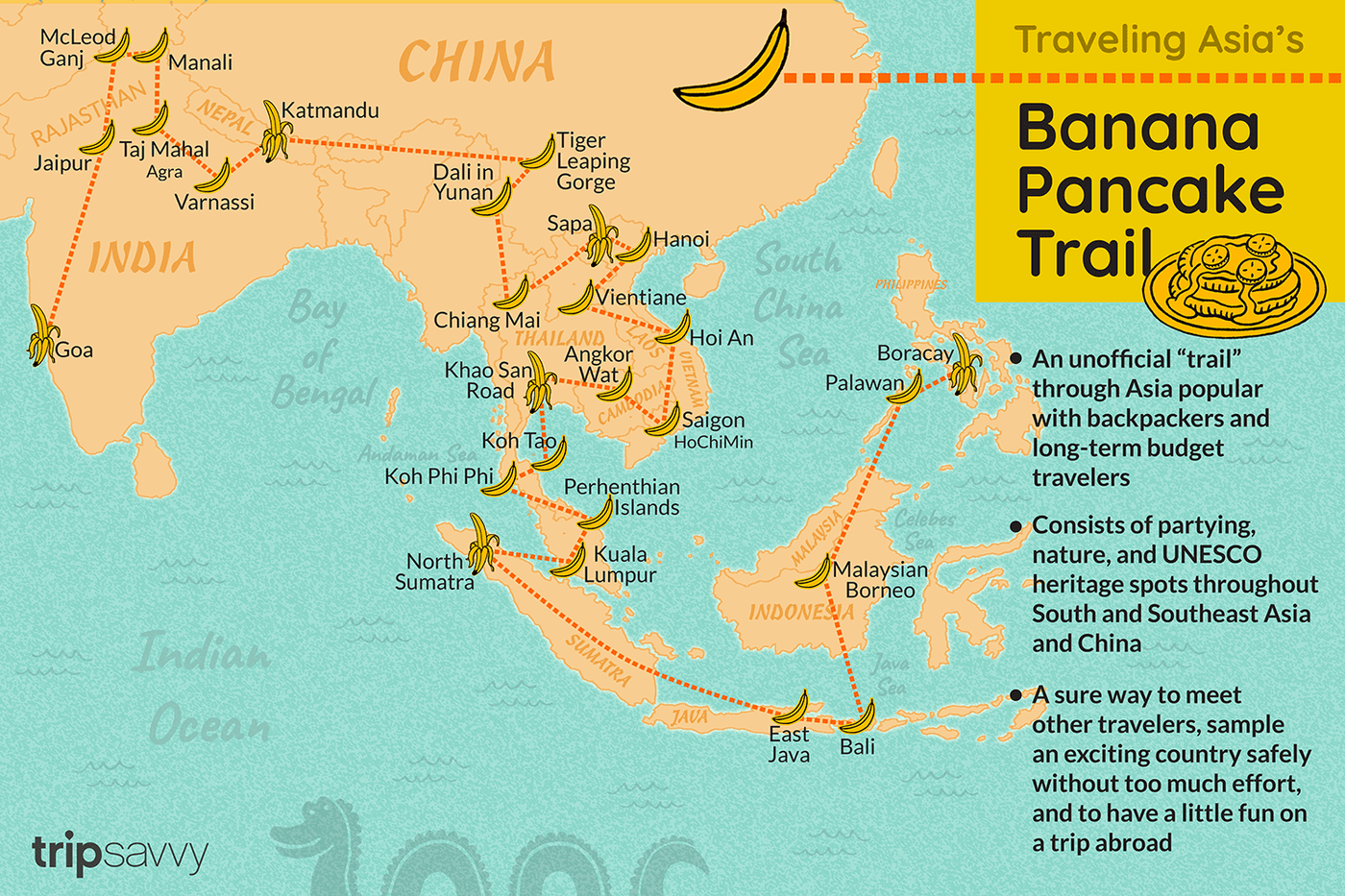
There are some other versions, similar with minor differences:

It can be seen from the figure that although there are different versions of the Banana Pancake Road, the main route points are concentrated in the Indochina Peninsula, which was formerly known as "Indochina", which refers to the area between the east of the Indian subcontinent and the south of mainland China, which is affected by the two Mainland Southeast Asia influenced by the local civilization system. Today's English is also known as "Mainland Southeast Asia".
Before we set off to determine the route, we also communicated our intentions with some community partners. Some people are already in Singapore and Vietnam, and some people are planning to go to Bali Island. Maybe there will be news and investigations from these places later. ——We decided to focus on Thailand under the premise of limited time and energy.
This has proven to be a country that is quite friendly to digital nomads, in fact, they are friendly to everyone!
4. Four cities as destinations
After deciding to mainly visit Thailand, we began to choose specific locations and routes.
Thailand, a constitutional monarchy in Southeast Asia, with Bangkok as its capital and largest city. Thailand is located in the middle of the Indochina Peninsula, bordering the Gulf of Siam and Malaysia to the south, Laos and Cambodia to the east, and Myanmar and the Andaman Sea to the west. It has a land area of 513,000 square kilometers, slightly larger than Sichuan (48.6) or Heilongjiang (48.6), and a population of nearly 70 million, which is roughly equal to the population of Hunan as a whole. Thai is the main ethnic group, accounting for 75% of the total population. About 14% of the Thai population is of Chinese descent, a considerable portion of which comes from the Chaoshan region of Guangdong Province, China. Thailand's population is mainly agricultural population, concentrated in the rice producing areas, that is, the central, northeast and northern parts of Thailand. Along with the process of globalization, Thailand is also in the process of industrialization. About 31.1% of Thailand's population is concentrated in big cities such as Bangkok, and it continues to grow. Most of Thailand has a tropical monsoon climate. The perennial temperature does not drop below 18°C, and the average annual precipitation is about 1000 mm. From November to February, it is relatively dry under the influence of the cooler northeast monsoon. From March to May, the temperature is the highest, reaching 40-42°C. From July to September, it is affected by the southwest monsoon, which is the rainy season. In 2016, Thailand's total GDP was US$406.8 billion, with a per capita GDP of US$5,908.
The most important cities in Thailand include the capital Bangkok and the second largest city Chiang Mai. In addition, the southern islands of Phuket and Surat Thani are also very popular with tourists and digital nomads.
We decided to focus on Bangkok, Chiang Mai, Phuket, and Penang, Malaysia when we changed visas. Although Penang is very close to Kuala Lumpur and Singapore to the south, considering factors such as the convenience of visas and the fact that some people have been stationed in Singapore, it was finally determined that the above four cities should be used as the actual itinerary for the inspection.
We were in Dali before the start of this plan, so the main routes marked in the picture include Dali, Chiang Mai (and surrounding Pai County), Bangkok, Phuket and Penang. Interestingly, these cities are almost on the same meridian from north to south.
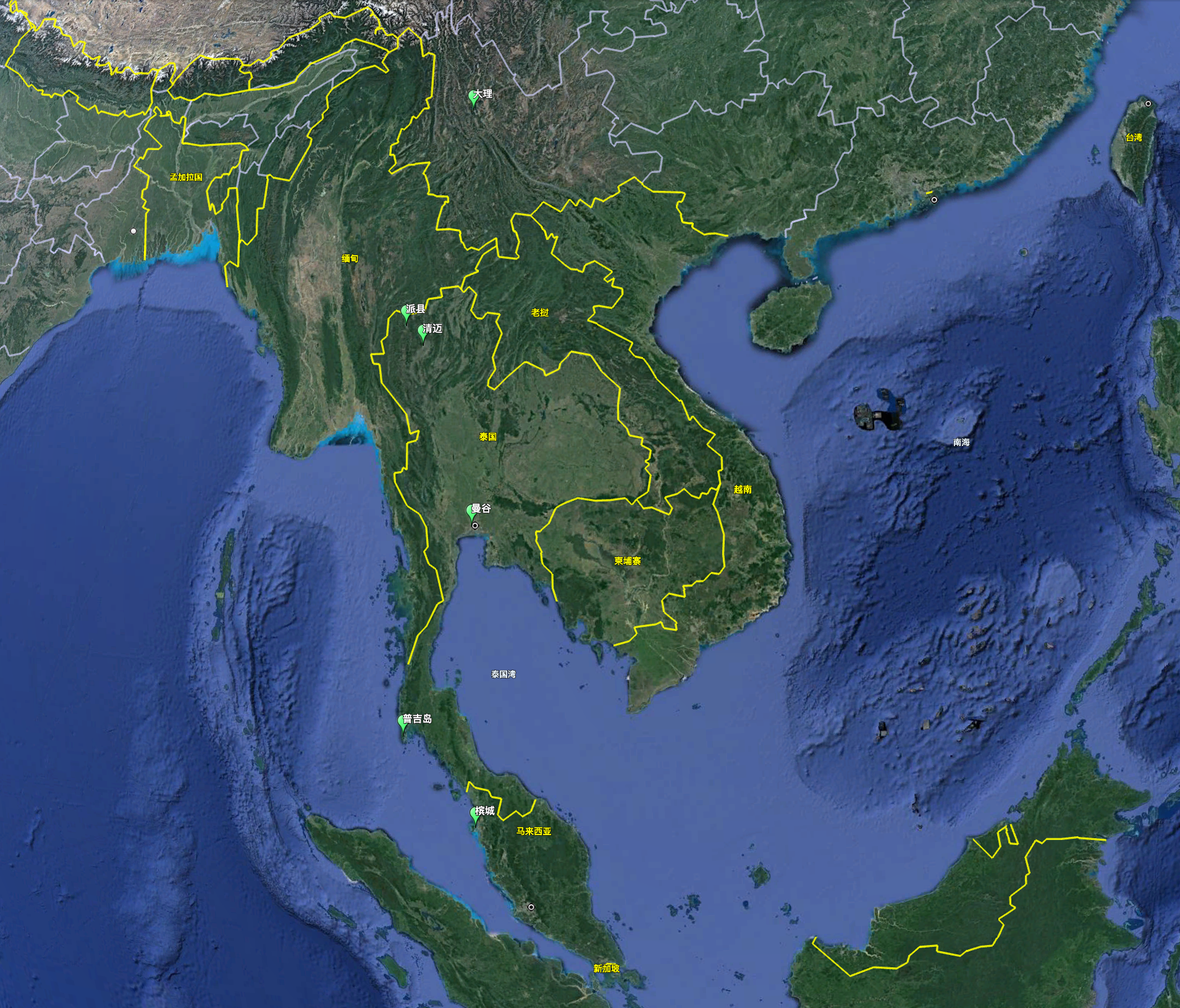
From the perspective of straight-line distance, the approximate spacing of these places from north to south is as follows:
Dali - 800km - Chiang Mai - 700km - Bangkok - 700km - Phuket - 400km - Penang
Although these places are all in the tropical marine climate zone, the climate is obviously different:
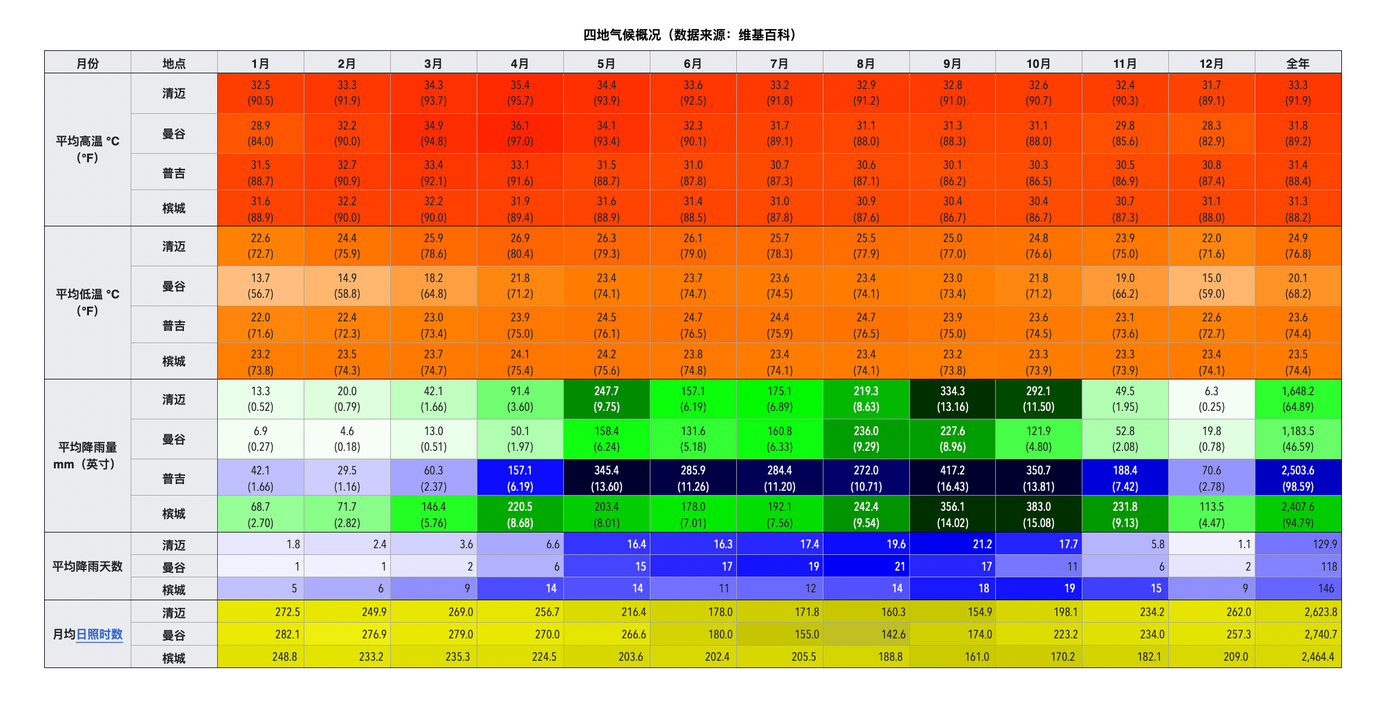
In terms of climate data, Bangkok is the most balanced and suitable, relatively cool, dry and sunny; Phuket has the largest precipitation.
But as far as my personal experience of this trip is concerned, the weather in Chiang Mai is also very comfortable, while Phuket and Penang are relatively hot and humid, which may be the reason why it is November.
In terms of cost of living, you can refer to the ranking of the cost of living index (CLI) of ASEAN cities, which is weighted by rent and additional costs, daily necessities prices, restaurant prices and purchasing power index:
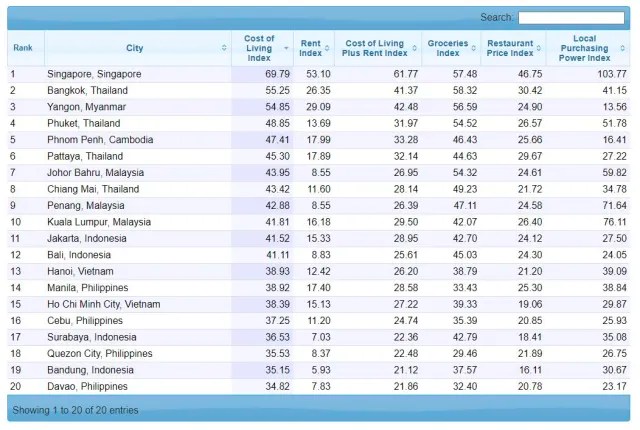
It can be seen that Bangkok ranks second after Singapore, Phuket ranks fourth, Chiang Mai ranks eighth, and Penang ranks ninth. This ranking is completely in line with the personal feelings of this trip.
However, it should be noted that in tourist cities, the difference in rent between peak season and off-season is very large: because Phuket is located on an island, it is already a world-renowned tourist city that is popular with tourists from all over the world. Refers to a large number of Russians coming to Phuket. According to social media information, the number of Russians who have come to Phuket has reached nearly 100,000 in the near future, and the resident population of Phuket is less than one million.
When we joined some local communities during our investigation in Phuket, we also found that there is a large-scale Russian-speaking community in Phuket, which corroborates what the news said.
Therefore, Phuket has been more affected than other cities. Judging from the main booking website apps, the rent in the near future (winter 2022) will also be significantly higher than that of other cities.
In addition, an Englishman who has lived in Phuket for 16 years told us that the peak season in Phuket gradually fades from February, and the off-season begins in May, which is the most suitable time to find a house in Phuket.
The off-season in Chiang Mai starts at the end of January, and the off-season starts from May to June until the Loy Krathong Festival and winter (November). From February to April every spring, farmers around Chiang Mai set fire to grass, which would lead to smog with PM2.5 seriously exceeding the standard.
Another thing to note is that this cost of living index ranking does not include travel costs. In Thailand and Southeast Asia, urban planning is very different from that in China. Due to the hot weather, the range within walking distance is very limited; Bangkok and Penang have relatively complete public transportation, and light rail and buses are more developed; although Phuket and Chiang Mai have public transportation Transportation, but basically must rely on taxis, rental cars or motorcycles. The rent of motorcycles is very cheap, but the traffic in the four cities is generally chaotic, and the speed of the main road is relatively fast, so there is a certain degree of traffic congestion. The motorcycle accident rate in Thailand ranks first in the world. We remind everyone to pay attention to safety and abide by local traffic regulations when riding. Another thing to note is that Thailand is a country that drives on the left. Generally use Google Maps navigation in Thailand.
In Southeast Asia, taxi-hailing software generally uses Grab, which can also be used to order meals. In addition, taxi-hailing software can also use InDrive. FoodPanda and Wukong Food Delivery are also popular apps. For online shopping, LAZADA and Shopee are the most commonly used.
In terms of human geography, Thailand is a Buddhist country with simple folk customs. There are many descendants of Chinese people in northern Thailand who can communicate in Chinese, and Bangkok has a famous Chinatown. There are many Chinese in Malaysia, and their Chinese proficiency is almost the same as that of Chinese. Phuket is more cosmopolitan, but there are also many new Chinese immigrants. Malaysia is a Muslim country. Compared with Thailand, intuitively, it is more passionate and free. In terms of gay rights and the legalization of marijuana, Thailand is far ahead of the world. The taboo topics of freedom of speech are only related to the royal family and religion.
Another very important point is the digital nomad community atmosphere. Thailand is a country friendly to digital nomads, and there are many digital nomads in Bangkok, Phuket, and Chiang Mai. They come from all over the world and work in all walks of life. According to random interviews, most of them are software engineers, designers, self-media, marketing and sales. The picture below is PunSpace, a shared office space in Chiang Mai. From the picture on the upper right, we can see that the digital nomads who work here are mainly from European and American countries.
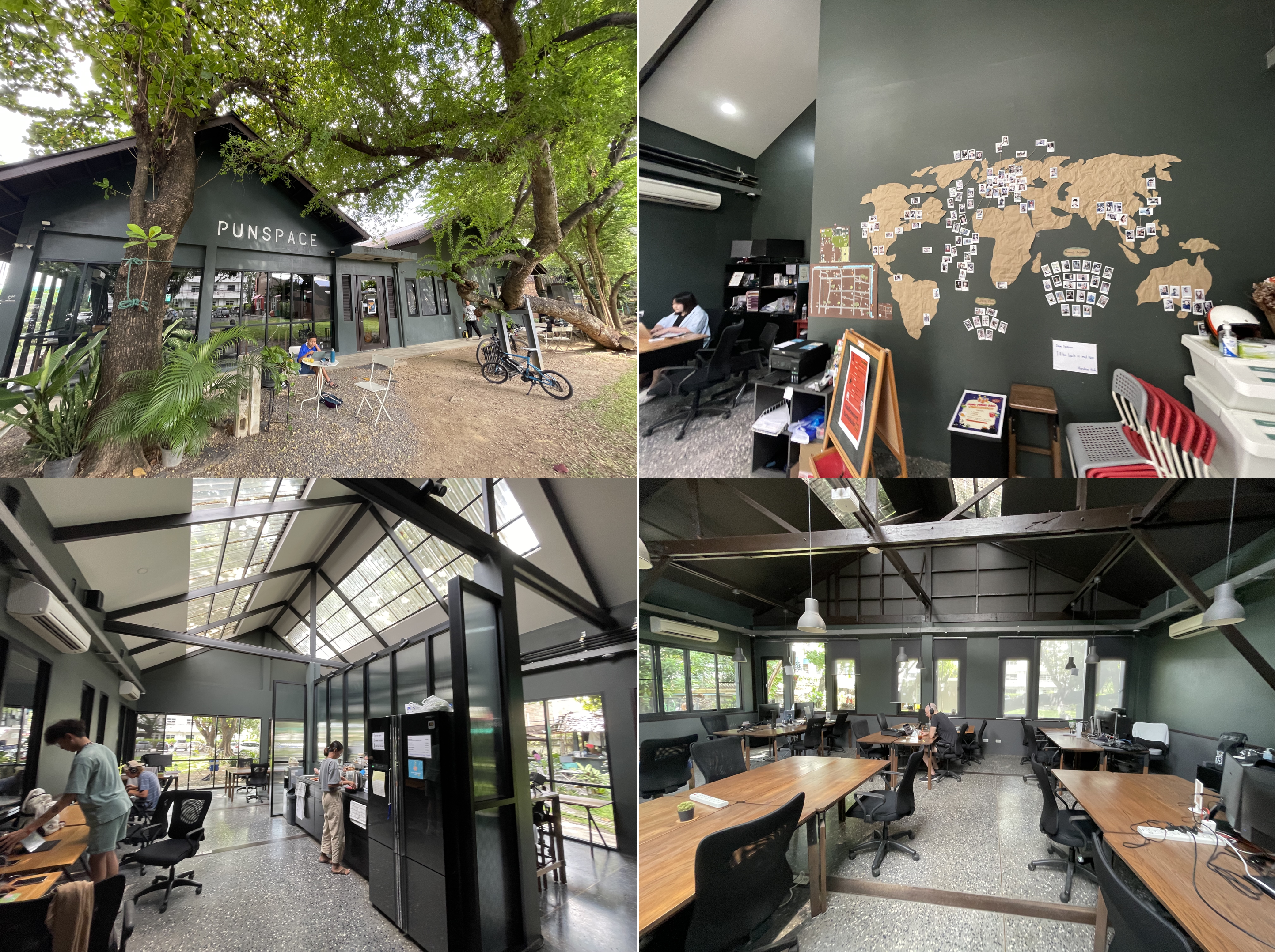
Phuket has the best Web3 atmosphere, with regular offline activities in English and an "encryption cafe"; Bangkok just held a blockchain week event in November; Chiang Mai also has irregular activities and lectures. There is also a bitcoin meetup in and around Chiang Mai University. It can be seen that Thailand's digital nomads and encryption atmosphere are very good.
In addition, these cities have shared office space, Chiang Mai is the most densely populated, and Penang has a strong atmosphere of innovation and shared office, but it should have just started, and the scale is limited to one block:
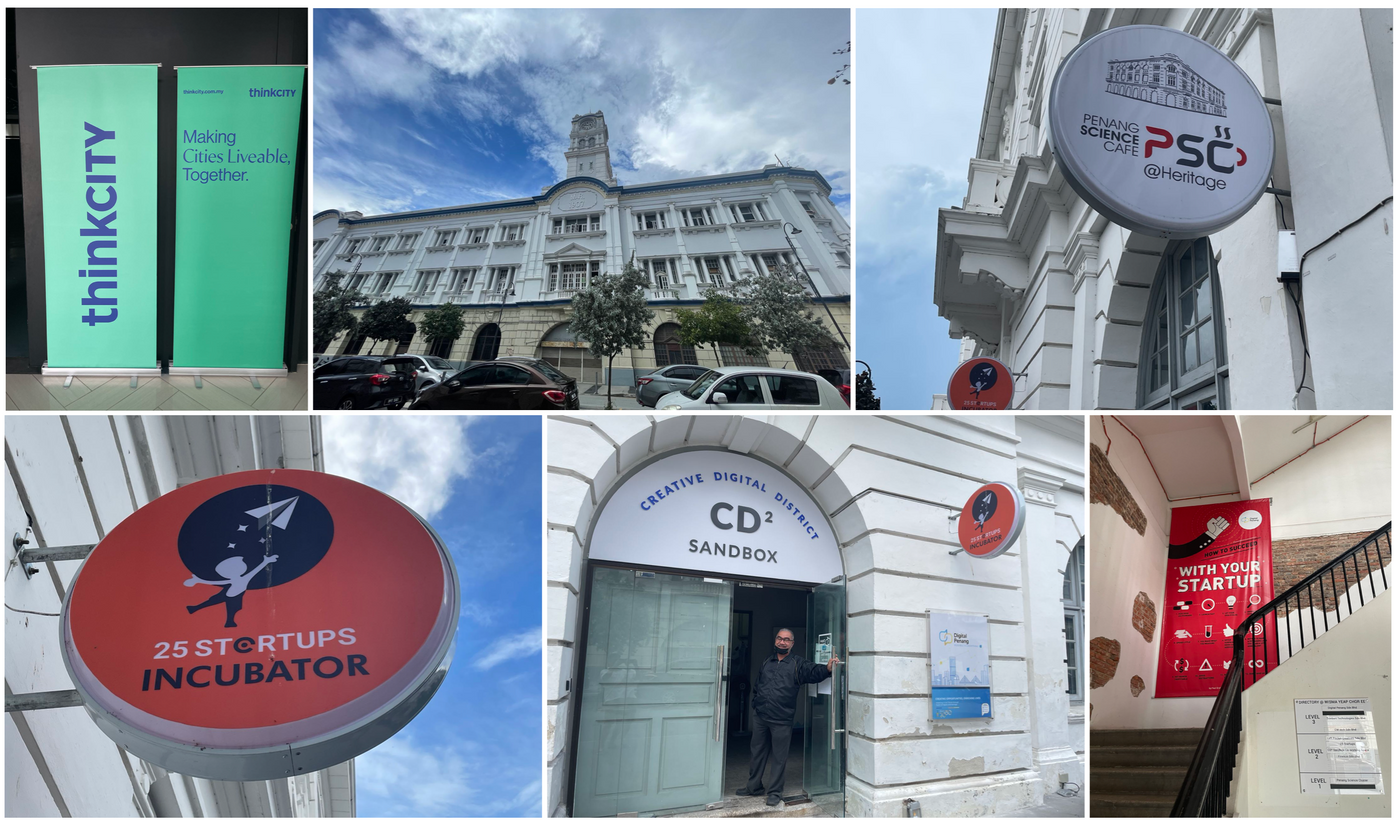
A more intuitive analogy is that Bangkok corresponds to Shanghai, Phuket corresponds to Sanya, and Chiang Mai corresponds to Dali. If you have a preference for these three Chinese cities in terms of personal choice, then you can quickly match these three cities in Thailand. And there is no need to be too entangled, there are many flights between these places, and the air tickets are also very cheap. You can choose one of them first, and then slowly explore the experience.
5. Thailand is a novice village, and Chiang Mai is the starting point
After examining the climate, cost, atmosphere, etc., we concluded that Thailand is a novice village for digital nomads, with a strong atmosphere for Web3 innovation and friendly visa policies. Among them, Chiang Mai has low food and living costs, and is geographically and culturally close to China. It is most suitable for establishing an outpost of the offline digital nomad community and the starting point of the great Web3 channel. Bangkok and Phuket can be considered as follow-up nodes for Thailand’s digital nomad community after the establishment of this outpost.

It is believed that every new digital nomad who grows up from Xinshou Village can set sail from the starting station of this great waterway and sail to a further world.
Next: Digital Nomad Community Methodology - Starting from Chiang Mai
"Frontier has four possibilities: land, internet, sea and space. 'Internet Frontier' is easier than the other three. If we are lucky, we will be able to use the concept of the cyber nation to reclaim the physical frontier through the hybrid Internet/land strategy described in this book. "
- Balaji: Network Nation
1. Overview of Chiang Mai
Chiang Mai is the largest historical and cultural city in northern Thailand, with a population of about 1.2 million. Chiang Mai is the second largest city in Thailand and the political and economic center of northern Thailand. It is the capital of Chiang Mai and the capital of the Lanna Kingdom from 1296 to 1768. The Lanna Kingdom later developed into a tribute to the Chiang Mai Kingdom from 1774 to 1939. country. Chiang Mai is 700 kilometers from Bangkok, leaning against the highest mountain in Thailand. Chiang Mai is in the basin of the Ping River, the main tributary of the Chao Phraya River. Chiang Mai means a new city in Thai, which was taken when the Lanna Kingdom established its capital in 1296, thus replacing Chiang Rai as the capital of Lanna. The population is about 1.2 million.
The ancient city of Chiang Mai is a square town with a side length of one mile, surrounded by a moat. The ancient city was once the capital of the ancient Lanna Kingdom, and there are many temples and places of interest.
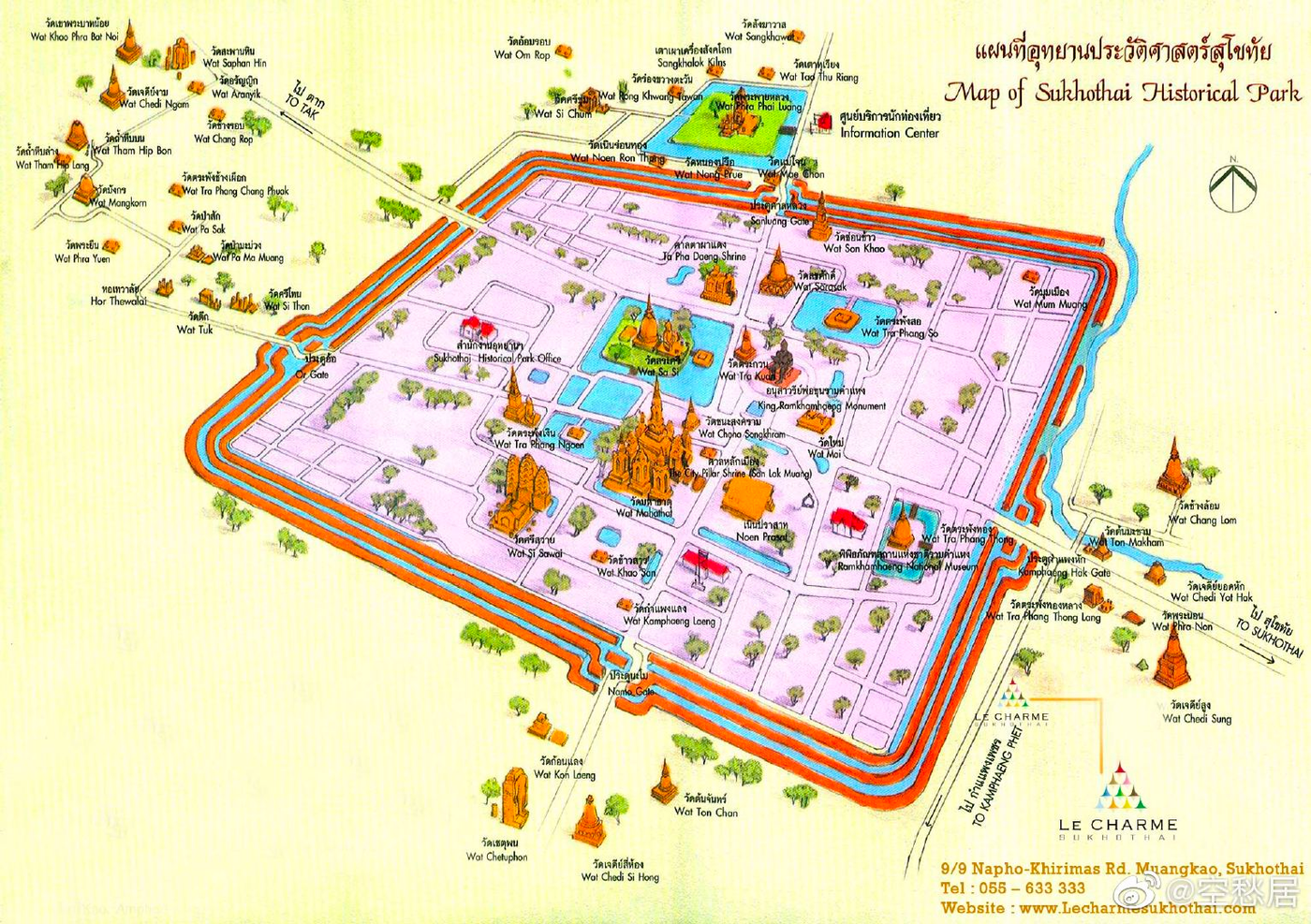
The airport is in the southwest of the ancient city, and Chiang Mai University is in the northwest of the ancient city. Nimman Road is the youngest and most vibrant neighborhood in Chiang Mai. To the west is Doi Suthep, and there are scenic spots such as Shuanglong Temple. The east gate of the ancient city of Chiang Mai is called Tha Pae Gate, which is the most prosperous place in the ancient city, and there is also a night market outside the city gate.
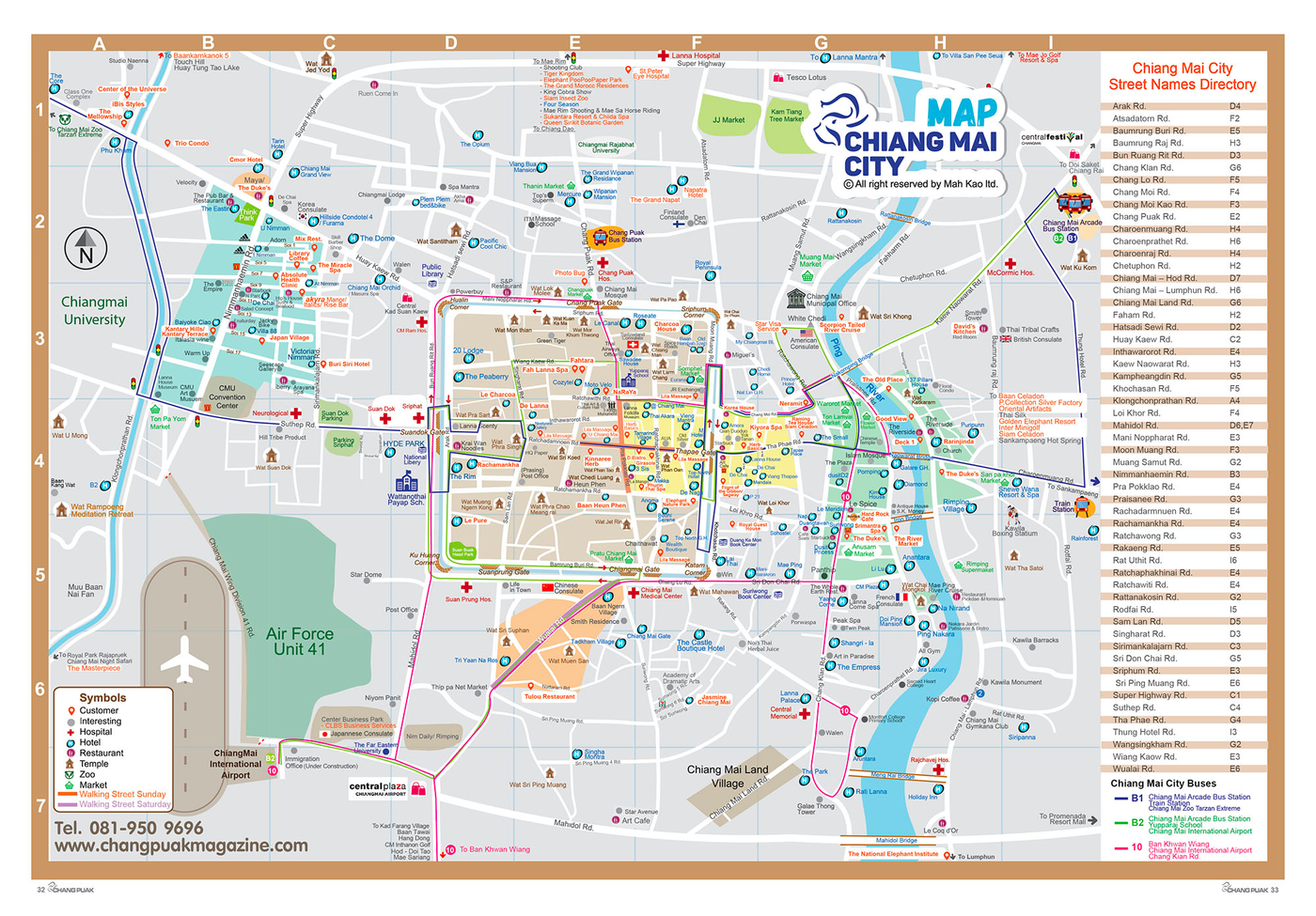
Within a distance of more than ten kilometers from the ancient city, Meilin in the north, Hang Dong in the south and Saint-Campan in the east are all quiet and livable areas. Many Chinese live in Hangdong, and formed their own community, and established a very ideal living community. During the conversation, I learned that these Chinese communities mainly focus on accompanying students and providing for the elderly, and some people are engaged in business, real estate, lawyers and other industries, providing a large number of infrastructure construction services for the community.

Main roads and ring roads in Chiang Mai: If you travel by car, you can go to the surrounding area through the road network. It is generally easier to find a parking space in Chiang Mai, and the traffic congestion in peak traffic is better than that in Bangkok, so it is more suitable for self-driving. However, it should be noted that the Chinese driver's license and its translation are not recognized by local laws and regulations. It is necessary to exchange for a local driver's license in Thailand after double certification, or to obtain another test.

The central urban area of Chiang Mai is roughly composed of the following areas, which are also the most visited and prosperous places.

2. Forms of digital nomad communities: the choice of living environment
If you want to find a place to live in Chiang Mai, you have many options. In addition to providing short-term daily rate hotels, B&Bs, and resorts, there are also apartments, townhouses or single-family bungalows or villas, and many foreigners buy real estate or real estate here.
Apartments (Condo) are centrally managed, generally 30-80 square meters, often equipped with gyms and swimming pools. Generally, the annual rental contract is the main one, and some also provide short-term rentals charged on a monthly basis. In the case of annual rent, the monthly rent ranges from 6,000 baht to 30,000, which is equivalent to RMB 1,200 to 6,000 per month. The apartment is fully furnished and requires no tenant maintenance.
After returning to Chiang Mai after finishing the four-city inspection in mid-November, our main task became house inspection. From B&Bs, hotels to apartments, villas and resorts, I have basically lived in various places. To sum up, we suggest short-term and personal consideration of apartments. There are many options along Ningman Road and Changkang Road. Take Astra Sky River Condo on Changkang Road, which is said to be the most complete, as an example. It has an infinity swimming pool, a gym, a wet and dry steam room, a reading room and a meeting room, and the facilities and services are very complete.

There are many choices of villas ( Villa , also called House ). From hundreds of square meters, 1-2 bedrooms, to thousands of square meters, 8 bedrooms. The monthly rent is slightly more expensive than that of an apartment. If the outdoor area is relatively large and the number of rooms is relatively large, maintenance, sanitation and other costs need to be considered.

Resort (Resort) : For the community, a space that can accommodate 20-30 people, the best choice is the resort. Below is one of the resorts we reviewed. This is a resort located in the northeast of Chiang Mai that is looking for long-term rental or even considering cooperation or transfer. It is not far from the ancient city (5km) and has enough public space - gym, kitchen and canteen, conference room, there is also a bar counter, swimming pool and plenty of beds. There are 6 villas with a total of 6 rooms, 6 houses with a total of 12 rooms, and 22 apartments with a total of 40 rooms, which are very suitable for community use.

During our trip, we also contacted some other landlords who are willing to transfer and rent for a long time. There are also real estate developers who can cooperate in development, buy land to follow the architect's planning, design and construction, and the general construction period is one year. Due to the impact of the epidemic in the past three years, some resorts are in a state of insufficient passenger flow and barely maintained. The current rental and sales costs are relatively low. Communities that intend to establish local offline nodes can focus on this plan.
3. Community initialization: how to start operation
In recent years, the development of the digital nomad community in China has attracted much attention. A community with a good atmosphere can not only bring a lot of convenience to the life and work of the digital nomads, but also facilitate the possibility of all communication and collaboration inside and outside the community. Whether in Anji, Zhejiang, Dali, Yunnan, or Sanya, Hainan, many people have experienced digital nomadic life through domestic digital nomad communities.
The strong atmosphere of the digital nomad community in Dali has inspired such inspirations and actions as the "Wa Mao Summer", making Dali one of the most Web3-spirited cities in China. "Frozen three feet, not a day's cold", the continuous influx of digital nomads in the past two years, the organization and participation of local communities, and the continuous promotion and influence of social media influencers. The local cultural soil and the spirit of diversity and tolerance in Dali are all is an essential factor. This also gave us important methodological implications for implementing a digital nomad community in Chiang Mai.
The two most important factors in the offline community are "place" and "people". The choice of location can determine different goals in stages so as to adapt to the "people" factor. At the very beginning, people who arrived in various places began to understand and investigate. The size of these "advanced teams" is generally 2-5 people. They can settle down in the local area through short-term rent. It is recommended to rent a car to improve mobility in order to complete inspections, select Address and other work. Once the community's resolution is passed, the first offline node can be established in the form of long-term lease.
Implementing on-chain governance through Tokenization methods such as NFT is also a practical solution worth considering. An NFT-based offline community can be realized through on-chain governance, and its scenarios and influence are bound to bring more returns to the community. Various communities currently have many IRL methods and tools to assist in the realization, and offline communities are also providing specific scenarios for these attempts.
The choice of the community leader is also very critical, which largely determines the direction of the community culture. The community leader should grow with the community and provide pertinent and objective leading suggestions for the offline management and maintenance of the community. The diversification and reasonable division of labor of the early team will also play a vital role in the establishment of community nodes.
The early operating indicators of offline community nodes include increasing traffic and reservation rates, reducing vacancy rates, and achieving balance of payments as soon as possible. Offline activities should be held regularly. The atmosphere, attractiveness and influence of the community will depend on the input of early operators and all community members. There should be a compatible incentive mechanism design to attract more people to join the community.
Sustainable development can only be achieved by achieving a balance of revenue and expenditure. In terms of future plans, either "depth priority" can be adopted to purchase land and community design and construction to establish a longer-term and more stable node, or "breadth priority" can also be considered The way: establish another local node in Thailand, such as Bangkok or Phuket, and then go to the rest of the world.
4. Sustainable development of the community and positive externalities
If the net income of the community node can be greater than or equal to the expenditure, it is considered to have achieved a balance of payments; the community node can achieve a stable and sustainable development.
The simplest rough estimate: For example, for a 40-bed long-term rental resort, the general monthly rental cost and maintenance cost are about 200,000 baht, so the average monthly cost per bed is 5,000 baht, or about 1,000 yuan in RMB. But in fact, it is very difficult to achieve a full house every day. If the vacancy rate is always high, it will affect the income and competitiveness. Therefore, it is necessary to carefully plan and set the price. It is necessary to ensure that the price is reasonable, sufficiently attractive to digital nomads, and to ensure comfort. Cost factors must also be considered in order to achieve a smooth long-term balance of payments.
Based on the demand for governance on the chain, you can also consider using Web3's native infrastructure to reconstruct its sustainable development framework, use cryptocurrency to pay, use NFT to associate occupancy rights, etc., and even issue Tokens to raise funds for co-creation. direction. It is expected that more community members will be able to put forward new ideas and implement them on the issue of sustainable development in the community.
The essence of truly sustainable development lies in "entropy reduction". The degree of chaos in the system will always tend to be more chaotic without the intervention of external forces. Perfect governance principles and efficient collaboration are effective means to ensure system entropy reduction.
In the past, we have accumulated enough experience in digital nomad communities in Anji, Zhejiang, Dali, Yunnan and other places. We also look forward to bringing more beneficial experiences to the Chiang Mai node during the migration process of digital nomads.
The positive externalities of the community are obvious. Digital nomads can not only share living and working spaces in the community, but also build friendships and facilitate collaboration. Chiang Mai is a city with a long history of culture and is also an important agricultural town in northern Thailand. The surrounding slash-and-burn farming that burns vegetation often brings smog to Chiang Mai in spring. If it can be studied as an issue to help locals improve environmental issues, it is also of great practical significance.
5. Early work plan, timetable, and future arrangements
The early work has been gradually carried out. In line with the principle of "not re-creating wheels", each community can merge to-do items, clarify needs, and share experience, so as to establish offline nodes as soon as possible, enter the substantive operation stage, and provide necessary services for digital nomads as soon as possible. s help.
Here is a brief work plan that lasts eight weeks and can be used as a guide for the early operation of community nodes.
the first week:
Establish a community, the members of the community include the "advance team" in the local area, and the follow-up members who are preparing to go to the destination. Understand their needs, determine the arrival time and short-term plan. Local personnel collect and organize local information through various channels, provide it to the community, and select suitable solutions.
the second week:
Field visits. It is recommended to use self-driving, and you should not only inspect the house itself, but also inspect the surrounding business districts, transportation and other environments to confirm whether life is convenient, whether the environment is quiet enough, and the surrounding neighborhood and community conditions. On-site visits can consume a lot of time and energy, so you need to make adequate preparations in advance to efficiently visit enough listings.
The third week:
When you see enough listings, you can enter the negotiation process with the landlord. Generally speaking, on the similar topic of "picking the best", there is a "37% rule" that can be used for reference.
The 37% rule, from the book "The Beauty of Algorithms". It means that after the mathematician Euler's experiment, 37% is used as the cut-off point, and the previous time is used for observation, and the latter time is used for decision-making. For example, if you want to buy a house and there are 30 houses in the whole area, you need to look at 37% of the houses first, that is, 11 houses. The houses before 37% are only for viewing but not for buying, but remember what you think the best looks like. After reading it, from 37% onwards, you should start buying as long as you encounter a house that is better than the best before.
According to this principle, if there are 50 houses under a certain standard in a certain area, you only need to look at 19 houses, and then you can make a decision at any time as long as you encounter one that is better than the one you have seen before. This estimation avoids spending too long in the information black hole with ever-increasing content, and front-line field visitors must also rely on sufficient observation and analysis, group decision-making and judgment, and make decisions based on the needs and votes of community members.
When negotiating, you need to pay attention to skills, and you need to calculate the monthly flow costs clearly, and list as much as possible the parts that both parties need to bear. For example, in Thailand, the regular deworming of houses and the management and maintenance costs of swimming pools are all details that need to be confirmed.
the fourth week:
Complete the negotiation with the landlord and start renting the house. It is recommended that a local translator or lawyer participate in the signing; if a business license is involved, a lawyer is also required to be hired. Start necessary repairs and environmental design work, set up service processes such as room reservation system. Start hiring local service personnel. Thai law stipulates that in a joint venture company established in Thailand, foreigners can only hold a maximum of 49% of the shares; if four locals are employed, one foreigner can be granted a work visa.
fifth week:
Get ready to go live. Prepare for the launch ceremony, which will be announced by community organizations, invite guests to participate in the trial living experience, and formulate a schedule for follow-up regular community activities. Improve the financial reporting system and make regular public disclosures. It can continuously accumulate output content through reports, podcasts, live broadcasts, etc.
Sixth week:
The room reservation system or service process is launched. Recruit early members, further improve the process, and adjust the mechanism. Completed the launch ceremony, airdropped commemorative NFT, and continued media announcements. You can output text and blog content in the form of interviews with early members, and start preparing to collaborate with other communities to plan for the next offline hackathon and other activities.
Seventh week:
Start offline activities, which can be screenings and other activities at the beginning, and can be expanded into richer forms as community members join, such as outings, cultural experiences, or reading clubs, seminars and other themed activities. You can contact more local communities to further increase your influence.
Eighth week:
The early work is finished, and the cold start of the community is completed. Operations have stabilized. Review and summarize, accumulate experience and archive.
Within half a year after the Chiang Mai node goes online, the following goals should also be achieved:
1. Achieve monthly balance of payments, explore the path of sustainable development, and establish positive externalities.
2. Continue to output content and expand the influence of the geo-community network throughout Southeast Asia.
3. Summarize experience, prepare to open up new offline community nodes, and carry out in-depth investigation and research on digital nomad resorts in Southeast Asia.
4. Effectively connect domestic and foreign digital nomad communities, and establish the originating route of "Web3 Great Channel".
So far, we have been able to establish and operate the first digital nomad community in Chiang Mai, Thailand.
We hope that this goal can be achieved smoothly. It is expected that digital nomads can continue to innovate in this homeland, build communities in more places, connect with each other, open up new routes and achieve success!
Summarize
After two months of field research, we completed this report. I hope it can provide some current first-hand information reference for digital nomads and friends who are interested in building a digital nomad community.
This report draws a conclusion after observation, sorting and screening—Thailand is a novice village for digital nomads, and Chiang Mai is suitable as the starting point. We have started community site selection and early preparations in Chiang Mai, and we hope to meet more digital nomads and build an ideal community together.
We also gave specific suggestions for building a community based on field investigation and research, and provided some practical information. This information not only comes from our personal experience, but also a lot of useful experience from partners and community members we met along the way. I would like to thank the various communities here: thanks to SeeDAO, Four Seas Community, PlanckDAO, 706, DaliHub, MaskNetwork, RSS3, Nomadverse DAO , Matters, and Great Aviation DAO and other community partners, thank every friend we met online and offline, for their selfless help with this report, and for waiting patiently for Pirate Radio!
Also welcome to join the pirate radio community to discuss:
https://t.me/+au9dofcH3_w5MjEx
I hope to participate in the construction of the digital nomad community with you, and I look forward to meeting you soon!
—— HYDAO Pirate Radio December 7, 2022
Like my work? Don't forget to support and clap, let me know that you are with me on the road of creation. Keep this enthusiasm together!








